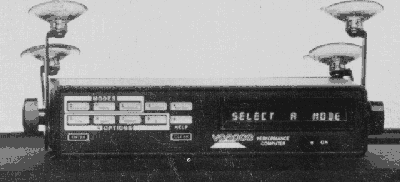
The Traffic Accident Reconstruction Origin -Article-


The Traffic Accident Reconstruction Origin -Article-
|

|
by Joseph Cofone
I'd like to share some of my experience with the Vericom VC 2000. The VC 2000 is a critically damped accelerometer that measures G force in real time at the rate of 100 times per second. It also has an internal clock. To use the instrument it must be attached to the inside of a car. The car is then skidded on the surface in question. It integrates the time and G data to calculate distance and speed. I have used the instrument for approximately eight years and have personally run or participated in more than 200 tests. I have found the instrument be reliable.
In May of 1995 I attended a 16 hour class provided by VERICOM, the manufacturer. The training helped me to better understand the workings of the instrument. I highly recommend it to all. This training is offered around the country.
 When testing for friction, my protocol is to use the VC 2000 in addition to a drag sled. I pull the
drag sled at least 10 times along the
path of travel of the sliding vehicle or, in a yaw case, in the direction
of the angle of the striations . These drag factor values are averaged and it
is this averaged value that is compared to the average g value registered by
the VC 2000.
This practice provides two independent methods for measuring drag factor. As a law enforcement agency our
philosophy is to be conservative in the results obtained, so the lower value is used for subsequent
analyses. In general though, the readings for average drag factor using the VC2000 are lower
than those obtained with the drag sled.
When testing for friction, my protocol is to use the VC 2000 in addition to a drag sled. I pull the
drag sled at least 10 times along the
path of travel of the sliding vehicle or, in a yaw case, in the direction
of the angle of the striations . These drag factor values are averaged and it
is this averaged value that is compared to the average g value registered by
the VC 2000.
This practice provides two independent methods for measuring drag factor. As a law enforcement agency our
philosophy is to be conservative in the results obtained, so the lower value is used for subsequent
analyses. In general though, the readings for average drag factor using the VC2000 are lower
than those obtained with the drag sled.
These differences in readings may be due in part to the way many reconstructionists pull a drag sled. Many times I have seen the sled pulled in such a way that the point of dynamic friction is not arrived at. The sled seems to be "stuck" in a peak G mode as it were. If you compare the numbers obtained from the drag sled with the peak G values provided by the instrument, I think you'll likely see some correlation. That is, the drag sled usually displays a value close to the Peak G value measured by the VC 2000.
Theoretically the drag sled should provide reliable results. And it can, if used correctly. However practical application of the device can at times be difficult. Part of the difficulty in using a drag sled is there is so much to do and so little distance to do it in. In order to try to make the task easier we have employed a digital spring scale. Still, in many drag sled tests the readings remain higher than those obtained with the VC2000. A practical way to lengthen the distance over which the sled is pulled would decrease the disparity between both methods.
As stated in he introduction, the Vericom will display Drag Factor, Speed and Distance after each test. After a test, a check with the observed test skid marks usually shows them to be slightly shorter than the Vericom calculated distance. The reason that these visible skids are not the same length as the distance reflected by the instrument is that the VC starts to measure deceleration at a default threshold of .2g. Note, this is the beginning of the time interval used to integrate the velocity and distance. This threshold can be adjusted to .1g and there is an adapter that can be wired into the stop lamp fuse that will trigger the instrument at the moment the brake lamps come on.
As we know, the friction coefficient can change from place to place on the road, so in this regard I think the instrument does a better job than the drag sled. There are some models of the instrument that can provide the hard data. At present the instrument can only measure + and - acceleration on one axis at a time. It is my understanding that Vericom is working on a dual axis machine.
This friction testing protocol, established by the Bergen County New Jersey Prosecutors Office, uses the Vericom as a check to a drag sled. The method has served us well in both criminal and civil venues for many years.
Joseph Cofone recently began his 22nd year in law enforcement. The last 10 years have been with the Bergen County NJ Prosecutors Office where he has spent his entire tenure with the Fatal Accident Investigation Unit.
Mr. Cofone currently holds the rank of Sergeant. Prior to his employment with the BCPO he was a patrol and then traffic officer with the Lyndhurst NJ PD. Part of his duties there included the investigation of fatal and serious MV collisions. Mr. Cofone holds ACTAR certificate number 833.
|
Copyright ©
|